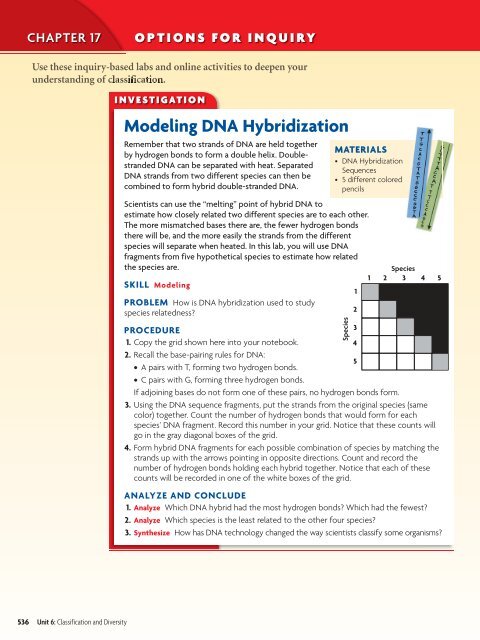Classification and Diversity
Classification and Diversity
Classification and Diversity
Create successful ePaper yourself
Turn your PDF publications into a flip-book with our unique Google optimized e-Paper software.
CHAPTER 17<br />
OPTIONS FOR INQUIRY<br />
Use these inquiry-based labs <strong>and</strong> online activities to deepen your<br />
underst<strong>and</strong>ing of classification.<br />
INVESTIGATION<br />
Modeling DNA Hybridization<br />
Remember that two str<strong>and</strong>s of DNA are held together<br />
by hydrogen bonds to form a double helix. Doublestr<strong>and</strong>ed<br />
DNA can be separated with heat. Separated<br />
DNA str<strong>and</strong>s from two different species can then be<br />
combined to form hybrid double-str<strong>and</strong>ed DNA.<br />
MATERIALS<br />
• DNA Hybridization<br />
Sequences<br />
• 5 different colored<br />
pencils<br />
Scientists can use the “melting” point of hybrid DNA to<br />
estimate how closely related two different species are to each other.<br />
The more mismatched bases there are, the fewer hydrogen bonds<br />
there will be, <strong>and</strong> the more easily the str<strong>and</strong>s from the different<br />
species will separate when heated. In this lab, you will use DNA<br />
fragments from five hypothetical species to estimate how related<br />
the species are.<br />
Species<br />
1 2 3 4 5<br />
SKILL Modeling<br />
1<br />
PROBLEM How is DNA hybridization used to study<br />
species relatedness?<br />
2<br />
PROCEDURE<br />
3<br />
1. Copy the grid shown here into your notebook.<br />
4<br />
2. Recall the base-pairing rules for DNA:<br />
5<br />
• A pairs with T, forming two hydrogen bonds.<br />
• C pairs with G, forming three hydrogen bonds.<br />
If adjoining bases do not form one of these pairs, no hydrogen bonds form.<br />
3. Using the DNA sequence fragments, put the str<strong>and</strong>s from the original species (same<br />
color) together. Count the number of hydrogen bonds that would form for each<br />
species’ DNA fragment. Record this number in your grid. Notice that these counts will<br />
go in the gray diagonal boxes of the grid.<br />
4. Form hybrid DNA fragments for each possible combination of species by matching the<br />
str<strong>and</strong>s up with the arrows pointing in opposite directions. Count <strong>and</strong> record the<br />
number of hydrogen bonds holding each hybrid together. Notice that each of these<br />
counts will be recorded in one of the white boxes of the grid.<br />
ANALYZE AND CONCLUDE<br />
1. Analyze Which DNA hybrid had the most hydrogen bonds? Which had the fewest?<br />
2. Analyze Which species is the least related to the other four species?<br />
3. Synthesize How has DNA technology changed the way scientists classify some organisms?<br />
Species<br />
536 Unit 6: <strong>Classification</strong> <strong>and</strong> <strong>Diversity</strong>

















